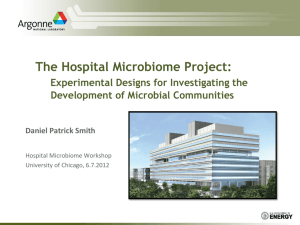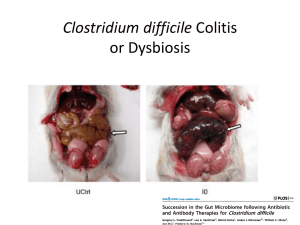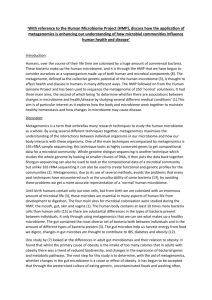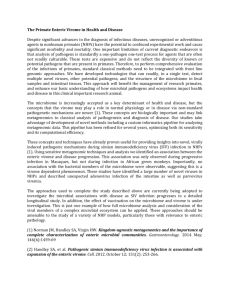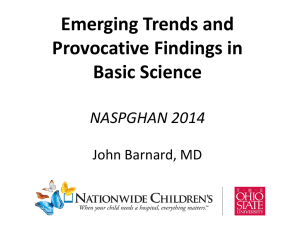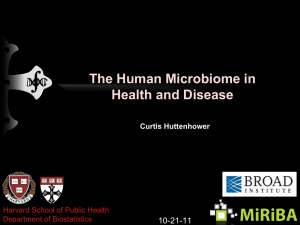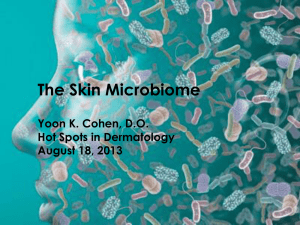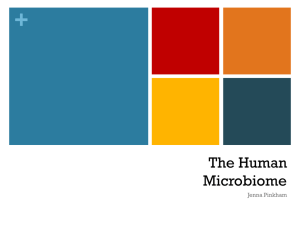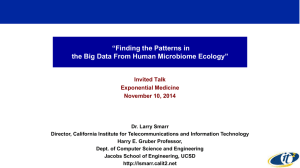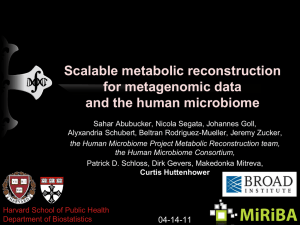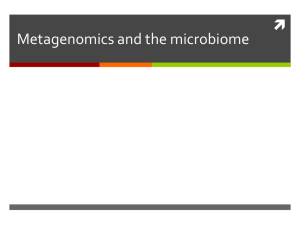The NIH Human Microbiome Project
advertisement
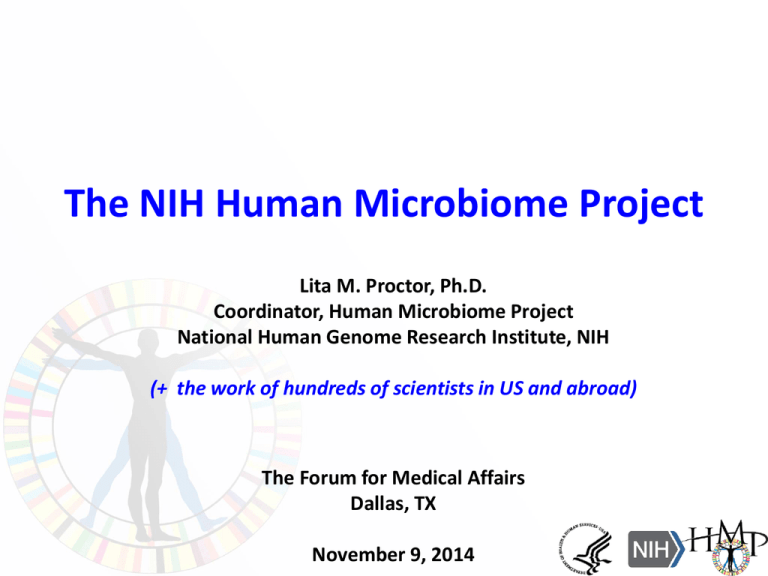
The NIH Human Microbiome Project Lita M. Proctor, Ph.D. Coordinator, Human Microbiome Project National Human Genome Research Institute, NIH (+ the work of hundreds of scientists in US and abroad) The Forum for Medical Affairs Dallas, TX November 9, 2014 1 2 Catalysts for creation of the NIH Human Microbiome Project Autoimmune diseases Bach, 2002 Infectious diseases ~1400 human pathogens vs. ~10 million microbial species on Earth, most which are beneficial Follow on to Human Genome Project Human Microbiome Project (2008-2012): a community resource (http://commonfund.nih.gov/hmp) Phase 1: Survey of the microbiome in humans “Who’s there?” $175M: Common Fund & cofunding from NHGRI + NIAID + NIDDK + NIDCR + NIAMS + ORWH + NCCAM + ODS Is there a “core” microbiome? Healthy cohort study Demonstration Projects Clinically healthy 300 male/female Microbiome-associated conditions Skin: eczema, psoriasis, acne 18-40 y.o. 5 major body regions (18 body sites) Up to 3 visits in 2 yrs No antibiotics, probiotics, immunomodulators GI/oral: esophageal adenocarcinoma, necrotizing enterocolitis, pediatric IBS, ulcerative colitis, Crohn’s Disease Urogenital: bacterial vaginosis, circumcision, sexual histories NIH Human Microbiome* Project (2008-2012) (Canada) * Human microbiome: full complement of microbes living in/on the human body and their collective genes & genomes. Sequencing Centers Demonstration Projects Data Analysis & Coordination Center Technology Development Computational Tools ELSI Clinical labs PCoA2 (4.4%) In healthy American adults, the microbial community composition in each part of the body is unique. PCoA1 (13%) For each person, est. 1,000 bacterial species and 2,000,000 bacterial genes. Total pool, est. 10,000 species and 8,000,000 genes. 7 Human Microbiome Project Consortium (2012a) In fact, microbial composition of healthy adult microbiomes is highly variable. Yet, genetic potential of each microbiome is less variable. Microbial composition of each body site community Airway Skin Oral (1) Oral (2) Oral (3) GI Tract Urogenital Phylum level Proportion metabolic pathways of eachmay bodynot siteoccur community AMicrobial ‘core’ microbial composition with host phenotype. However, a ‘core’ metagenomic and/or functional profile may occur with host phenotype. Human Microbiome Project Consortium (2012b) Subject Microbial composition may not be the property of interest Microbiome Property E.C. categories E.C. categories 10 most abundant microbial taxa in metagenomes of subjects in cohort Variability betw. subjects Variable 10 most abundant microbial metabolic genes in metagenomes of subjects in cohort Not variable 10 most abundant expressed microbial metabolic genes in metatranscriptomes of subjects in cohort Variable 9 Franzosa et al. 2014 Recall: the metagenome is the genetic “blueprint” of the microbiome. metabolism What biological properties do we need, to understand the role of the microbiome in the human: transcripts? proteins? metabolites? Human Microbiome Project (2013-2016): a community resource (http://hmp2.org) Phase 2: Integrative HMP “iHMP” what are they doing? $25M, Common Fund & NIDDK + ORWH + NCCAM + ODS Biological properties of both microbiome and the host microbial composition & gene expression, proteins and metabolites from microbiome and host longitudinal cohort studies integrated datasets of these properties as a community resource Exemplar microbiome-associated human conditions: Dynamics of Pregnancy and Preterm Birth: Vaginal & gut microbiomes and host (mother, infant) properties Dynamics of IBD Onset: GI microbiome and host properties Dynamics of Type 2 Diabetes Onset: GI & nasal microbiomes and host properties NIH Human Microbiome Project (2013-2016) iHMP Research Consortium (15 institutions) Pregnancy & Preterm Birth study: Buck/Strauss/Jefferson (VCU) IBD onset study: Xavier/Huttenhower (Broad, Harvard) T2D onset study: Snyder/Weinstock (Stanford, Jackson Lab) iHMP Data Analysis and Coordination Center: White (Univ MD) iHMP marker paper Cell Host & Microbe, Sept. 2014, vol. 16, issue 3 (open access) iHMP marker paper describes: 3 longitudinal cohort studies & their hypotheses sampling protocols for both microbiome and host different ‘omics data being collected where these data will be deposited 13 Dynamics of Pregnancy and Preterm Birth Study 14 Dynamics of Onset of Inflammatory Bowel Diseases 15 Dynamics of Type 2 Diabetes Onset 16 Integrative HMP website (http://hmp2.org) 17 Questions? lita.proctor@nih.gov 19

